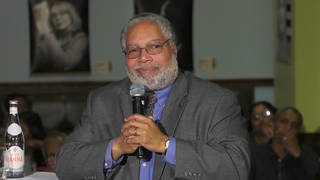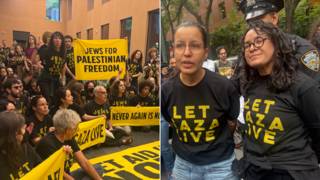
As the Supreme Court looks poised to uphold Mississippi’s 15-week abortion ban and possibly overturn Roe v. Wade, we speak to The Nation’s Amy Littlefield about her investigation into the Christian legal army behind the Mississippi law, as well as anti-trans laws across the country. She also critiques the mainstream pro-choice movement’s failure to center the poor and people of color. “There is a change coming within the movement because of its reckoning with these past missteps, including, frankly, the failure to adequately protect Black women and to stand up for the safety of the people whose rights were eroded first,” says Littlefield.
Transcript
AMY GOODMAN: This is __Democracy Now!_, democracynow.org, The War and Peace Report. I’m Amy Goodman.
We begin today’s show looking at the fight for reproductive rights as the Supreme Court appears set to uphold Mississippi’s 15-week abortion ban and possibly overturn the landmark 1973 Roe v. Wade ruling legalizing abortion nationwide. If Roe v. Wade is overturned, almost half of U.S. states could rapidly make abortion illegal, thanks to so-called trigger laws already in place.
For decades, right-wing groups have been waging a war on abortion rights, and they appear to be closing in on their goal of overturning Roe, due in part to Donald Trump’s appointment of Amy Coney Barrett and Brett Kavanaugh to the Supreme Court. One right-wing group has played a key role in this movement, has been the Alliance Defending Freedom, a self-described “legal army” to fight abortion rights and LGBT rights, especially trans rights.
We’re joined now by Amy Littlefield, the abortion access correspondent for The Nation. She has two new pieces out this week: “The Christian Legal Army Behind the Ban on Abortion in Mississippi” in The Nation and “Where the Pro-Choice Movement Went Wrong,” which was an op-ed piece just published by The New York Times.
Amy, welcome back to Democracy Now! It’s great to have you with us. Can you start off by, well, responding to what happened, what you thought was most important to understand about the oral arguments in the Supreme Court on Wednesday? You were outside.
AMY LITTLEFIELD: [inaudible]
AMY GOODMAN: Amy, you’re muted. If you could start again?
AMY LITTLEFIELD: Can you hear me?
AMY GOODMAN: Yes, we can.
AMY LITTLEFIELD: OK. So, in terms of what was most remarkable inside the court, I mean, you have Amy Coney Barrett suggesting that the state forcing people to carry pregnancies to term in a country that has the highest maternal mortality rate in the developed world — you know, three times higher for Black women than for white women — that it’s no big deal to force people to give birth, because they can just bring the baby to the nearest fire station and give them up for adoption.
You have Brett Kavanaugh, who was confirmed saying over and over again that Roe was settled law, it was precedent, and that was that; then, on Wednesday, listing off all of the different precedents that the Supreme Court has overturned, and wouldn’t it be a good thing if they did that again?
So I think we saw really clearly that the three conservative justices that were appointed by Donald Trump are getting ready to do exactly what they were put on the court to do, which is overturn Roe v. Wade and take away the nationwide right to legal abortion in this country.
And I want to say that the biggest evidence, the biggest argument, if anyone had any remaining doubt that that’s what they intend to do, is not what was going on inside the court but what’s going on many miles away in Texas, where for three months people in the state of Texas, one of the country’s largest states, have been dealing with this slow-rolling emergency where almost all abortions in the state are banned under a law that empowers anyone to become a bounty hunter and enforce an anti-abortion law against friends, families, abortion funds, abortion providers, anyone who’s helping someone get an abortion. The Supreme Court could have stopped that law before it came into effect. They could have stopped it at any point, you know, over the past three months. And that hasn’t happened.
And so, I think the writing is really on the wall. And that’s why I’ve said I think the most important thing that I saw was not what was going on inside the Supreme Court, which was sort of confirmation that they’re going to do what the Christian right has been planning for decades, but what I saw outside was an abortion rights movement that was really emboldened, that was prepared, that was debuting the messaging that is going to be needed to rebuild a mass movement to change the culture and to reshape the fight in the years to come after the right to legal abortion falls.
AMY GOODMAN: I want to go to what was happening outside, just hours before the oral arguments on Wednesday. Activists shouting “Shout Your Abortion” gathered outside the Supreme Court building, chanting “Abortion pills forever,” then four of them proceeding to take mifepristone in union, the first medication in a typical two-step self-induced medical abortion.
ACTIVIST: Abortion!
CROWD: Abortion!
ACTIVIST: Pills!
CROWD: Pills!
ACTIVIST: Forever!
CROWD: Forever!
ACTIVIST: Abortion!
CROWD: Abortion!
ACTIVIST: Pills!
CROWD: Pills!
ACTIVIST: Forever!
CROWD: Forever!
AMY GOODMAN: Explain what they were doing, Amy.
AMY LITTLEFIELD: Yeah. So, these were activists with the group Shout Your Abortion. They gathered outside the court. They had white boxes with mifepristone inside them, which they had obtained legally from the group Aid Access, which is an organization based overseas that sends abortion medications to people all across the country. And the laws vary state to state on that access, but all of these activists were able to obtain that pill legally. It’s the first medication that people take in the typical two-step medication abortion regimen, which is administered in clinics, but it’s the same regimen that you can take at home. And they took the pill in front of the court. These were four people who had had abortions. Taking mifepristone by itself isn’t going to cause an abortion, but they were taking the pill to make the point that, as organizer Amelia Bonow told me, Republicans might have the courts, but we’re out here having abortions. Right? They can’t stop them. That was the point. They’re in open defiance of the court. They were saying, you know, “You can ban abortion legally, but now that these pills are out there, you can’t actually stop people from having abortion.”
The caveat to that — and it’s a huge caveat, obviously — is that what the state can do and has done is criminalize people for involvement in self-managed abortion. We’re likely to see that even further when Roe falls. But I think this direct action was really part of sending the message and trying to raise awareness about getting these pills into people’s hands, and part of the strategy of the movement figuring out how people are going to take care of each other and take care of those who need abortions in this post-Roe future that is imminently approaching.
AMY GOODMAN: Which sounds exactly like the pre-Roe past, though they might not have had those drugs at the time —
AMY LITTLEFIELD: Exactly.
AMY GOODMAN: — but people helping each other.
AMY LITTLEFIELD: Right, exactly. That’s the key difference, Amy, that those self-support networks are there. You know, that’s rising up. That’s been there for a long time in states like Texas that have heavily restricted abortion even before this year, but the tools are very different. Right? We’re talking about safe medication, the same medication, again, that you can get prescribed in a clinic that many people are now accessing in their own homes. The key is that a lot of people don’t know this medication is out there, and so I think the activists were really trying to say, “Hey, you know, everyone, pay attention to this. Tell all your friends. You know, these pills are available on the internet, and there are safer options now than there were before 1973.”
AMY GOODMAN: But, of course, there’s also severe danger, whether people are able to link into those networks.
AMY LITTLEFIELD: Right.
AMY GOODMAN: And we’re, of course, also talking about the poorest people in the United States, people who it would not be easy to cross state lines. I mean, even for anyone, it is difficult, but for people who don’t have the economic means, this will hit especially hard. And we’re talking about almost half of the country, half of states.
AMY LITTLEFIELD: Right, right, half of states. Half of states. And it’s already happening, right? I mean, abortion providers and activists in Texas are witnessing this reality every single day, of people who can’t afford to travel, who can’t get child care, who can’t take off work, who are pregnant, and they can’t escape their state, where abortion is banned except in the earliest weeks of pregnancy, and so they’re giving up, because they have no choice. And so, that’s already the reality for Texas, which I think, by one measure, is home to one in 10 women of reproductive age. And yeah, we’re going to see that multiply by potentially — I mean, not all states are the size of Texas, right? But we could see 26 states that are either certain or very likely to ban abortion if Roe falls, a dozen that would do it immediately through these trigger bans if Roe falls.
AMY GOODMAN: Amy, talk about the Christian legal army behind the ban on abortion.
AMY LITTLEFIELD: Yeah. So, this is really important, Amy. I went back and listened to a recording from 2018 when Alliance Defending Freedom, which is this legal engine behind the Christian right agenda, at a conference, an ADF attorney named Denise Burke said, “We’re going to lay out our plan here to eradicate Roe. And it starts with this Mississippi ban on abortion at 15 weeks, that was just introduced just this week in Mississippi. We introduced our model bill for banning abortion at 15 weeks, and this is going to go all the way to the Supreme Court.”
Now, at the time, she was saying, “This is going to go all the way to the Supreme Court, and then we’ll come in with a complete ban after we get the ban on abortion at 15 weeks.” There’s been a couple changes since then. They’ve gotten two more Supreme Court justices. And so, you know, they didn’t actually have to wait to ask the court to just go ahead and ban abortion outright, using this Mississippi law that was developed in 2018. But I thought it was really important to point out that this group was the legal architect of the bill that it now seems is going to be used to reverse Roe v. Wade.
AMY GOODMAN: So, Amy, I want to play a clip —
AMY LITTLEFIELD: Yeah.
AMY GOODMAN: — from that tape that you’re talking about —
AMY LITTLEFIELD: Oh, great.
AMY GOODMAN: — of attorneys with the Alliance Defending Freedom, or ADF, unveiling this plan, as you said, to eradicate Roe. This is ADF senior counsel Denise Burke speaking at the Evangelicals for Life conference.
DENISE BURKE: We’re not looking at regulation; we’re actually looking to enact abortion bans. We are working with allies in a number of states to do that. And our first ban that we are looking at is a 15-week limitation. So I’m sure you guys have heard about 21 states have enacted 20-week limitations to this point. The majority of those limitations were never challenged in court. I can speculate as to why the abortion industry did that, but I think they didn’t want to get a bad decision. They were concerned that the courts would go along with the 20-week ban. Well, I can guarantee you they’re not going to be able to ignore a 15-week limitation, which is, in essence, limiting abortion to the first trimester. And we’re kind of basically baiting them: “Come on! Fight us on turf that we have already set up and established.” I’m happy to say the first 15-week limitation based on our model language was just introduced in the state of Mississippi this week.
AMY GOODMAN: Amy Littlefield, respond to Denise Burke.
AMY LITTLEFIELD: Right. So, she’s very clearly saying, “Hey, guys, this is the plan. We’re going to introduce a 15-week ban.” They started. They introduced — you know, more than a third of states have implemented a 20-week ban, right? And they said, “Oh, that wasn’t enough to get the challenge that we wanted, and so we’re going to go ahead and move the line up to 15 weeks. And then, once we get that 15-week ban, we’ll go even further.” And so this was part of a carefully orchestrated effort to strike right at the heart of Roe v. Wade.
You know, Mississippi is getting a lot of attention right now, right? Everyone’s talking about Mississippi as if this was a state that grew — this was a bill that grew organically out of the soil of Mississippi. That is not the case. It was written by the Alliance Defending Freedom, which is an organization with a $50 million annual budget that is out there to drive the Christian right agenda. They write model bills. They work with state lawmakers who are aligned with them to introduce those model bills. Then, when the bills get challenged, which in many cases they want them to, they defend those bills in court. They fund the legal cases that they don’t defend themselves.
And what I most wanted to get across in this piece is the crucial connection that this organization that wrote the Mississippi law that is before the Supreme Court now is also the same organization that is driving the record number of anti-transgender bills that we’re seeing in state legislatures across the country. This year shattered records for both anti-trans legislation and anti-abortion legislation. And we are talking about those issues as if they’re two separate things, and really what I wanted to point out is this is the same organization that is driving these efforts as part of their Christian right agenda, and we have to understand those connections.
AMY GOODMAN: I want to go to Imara Jones. On Thursday, Democracy Now! spoke to the investigative journalist and host of The Anti-Trans Hate Machine podcast about the Alliance Defending Freedom and about how these attacks on reproductive rights, as you’re saying, Amy, are connected to the attacks on transgender rights.
IMARA JONES: A key way in which these two movements are linked is, in one way, very simple to explain. It’s the same groups and the same groups of people. We know that groups such as the Family Research Council, the Heritage Foundation and Alliance Defending Freedom have all been on the cutting edge of the anti-abortion movement for decades now. And they’ve just simply taken the tactics that they’ve learned from the anti-abortion movement and are now applying them to the anti-trans movement. So, for example, we are seeing doctors who provide gender-affirming care now being targeted by the right, with demonstrations outside, with posters, with videos online, being doxxed online, for example.
And it’s also the case that we have to remember that, for them, this is one fight. There is not a separation between the anti-abortion fight and the fight over trans rights. For them, they are essential in the vision of gender that for them is motivated and deeply rooted by the Bible. They feel that the United States is a white Christian nation, that it was ordained that way both by God and by the Constitution, although the Founding Fathers disagree with them, but, you know, facts don’t matter. And what they believe is that women having abortion, people being able to express whom they love through sexual orientation, and the ability to be able to live your true gender identity are all key elements in undermining white Christian America. And so, for them, again, this is one fight. And this is not the way that progressives view this. They view trans rights as kind of ancillary, as sort of on the margins, as not being an essential fight, as something that, you know, may be good or may not be good. But for the right, this is an essential fight.
AMY GOODMAN: So, that’s investigative journalist Imara Jones. Amy, as we begin to wrap up, that also leads into the piece you wrote, the op-ed piece you wrote for The New York Times this week, “Where the Pro-Choice Movement Went Wrong.” Can you talk, overall, about your thoughts on this?
AMY LITTLEFIELD: Yeah. I mean, this is a low moment for the movement for abortion rights, right? We’re potentially about to lose the legal right to abortion. And so, there are ample factors that have led us to this moment that were well beyond the control of anyone in the abortion rights movement, of course — right? — from the death of Ruth Bader Ginsburg during the Trump administration to gerrymandering by Republican lawmakers. But what I wanted to do is understand how the abortion rights movement is reckoning with this moment of loss.
So I spoke to more than 50 experts, abortion providers, activists, people involved in the struggle in one way or another. And a really important thread that emerged is that in the course of — basically, since Roe v. Wade happened, the white-led groups that have had the bulk of the resources and political capital within the abortion rights movement have often ceded ground and chosen to fight through the courts and fight a more defensive strategy that has really surrendered, at many key moments, the rights of women of color, Black women in particular, poor people, those whose rights and access were sort of the first to disappear in this incremental battle over abortion rights.
And that really starts in 1976 with the passage of the Hyde Amendment. Representative Henry Hyde, who brought it forward, said he wanted to restrict abortion for everyone, but alas, all he had was the Medicaid bill, and so he would have to just restrict it for poor people on Medicaid. And so, the Hyde Amendment, which banned the federal funding of abortion and eliminated access to abortion for most people who are on Medicaid in most states, was — you know, there were attempts to oppose it at the time, but really what ended up happening is that the Democratic Party and abortion rights groups, a lot of which were white-led at the time, sort of were willing to trade away access for poor people for other political priorities. And so, the Hyde Amendment, the ban on federal funding of abortion, sort of became accepted precedent and an accepted and routine part of the budget process for many years.
And we’re only starting to see that shift now. And I think that’s because the reproductive justice framework, the movement led by Black women, that has always known that Roe was not enough to protect rights for everyone, that has always known that the courts are not going to save abortion rights, because they haven’t saved the rights of people of color in the past — quite the contrary — you know, those movements are really sort of moving to the center of the frame and becoming more mainstream. We’re seeing for the first time in history that both NARAL and Planned Parenthood are led by women of color. And so I think there is a change coming within the movement because of it reckoning with these past missteps, including, you know, frankly, the failure to adequately protect Black women and to stand up for the safety of the people whose rights were eroded first.
AMY GOODMAN: Amy Littlefield, I want to thank you for being with us. We’ll link to your articles in The Nation and The New York Times. Amy is a journalist who focuses on reproductive healthcare and abortion access, correspondent for The Nation. Her new piece for The New York Times is titled “Where the Pro-Choice Movement Went Wrong.” Amy is a former producer here at Democracy Now!
Coming up, what happened to the Haitian asylum seekers in Texas, some of whom were whipped by U.S. Border Patrol agents? Stay with us.
[break]
AMY GOODMAN: “Dance of the North” by the award-winning Native American musician Joanne Shenandoah. She passed away last week at the age of 64.












Media Options